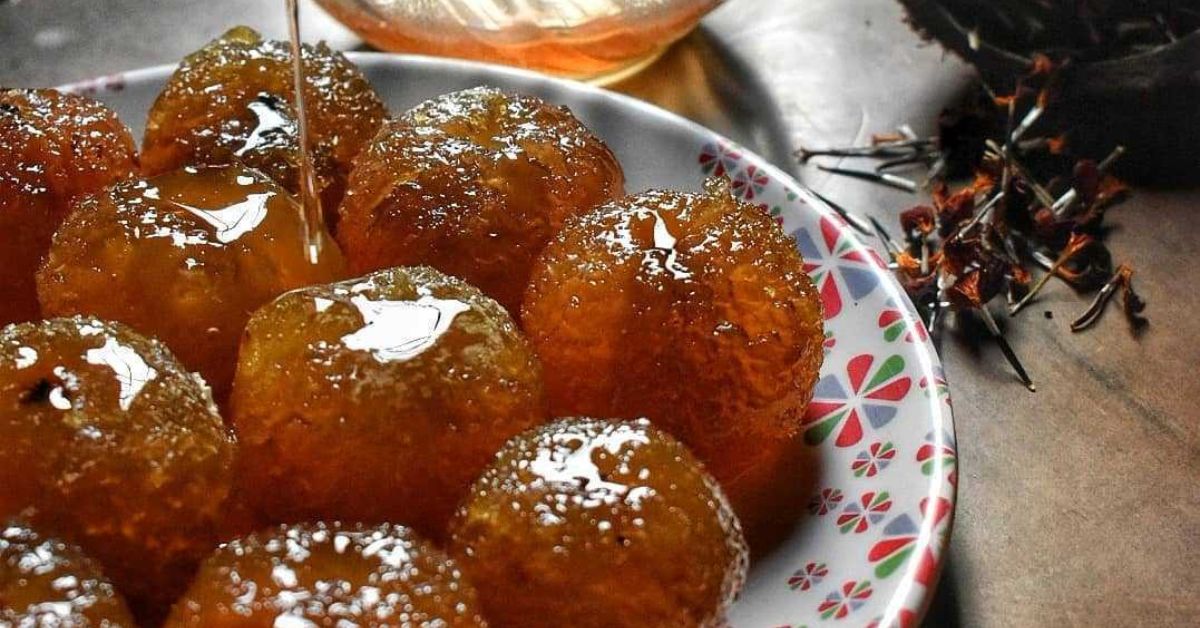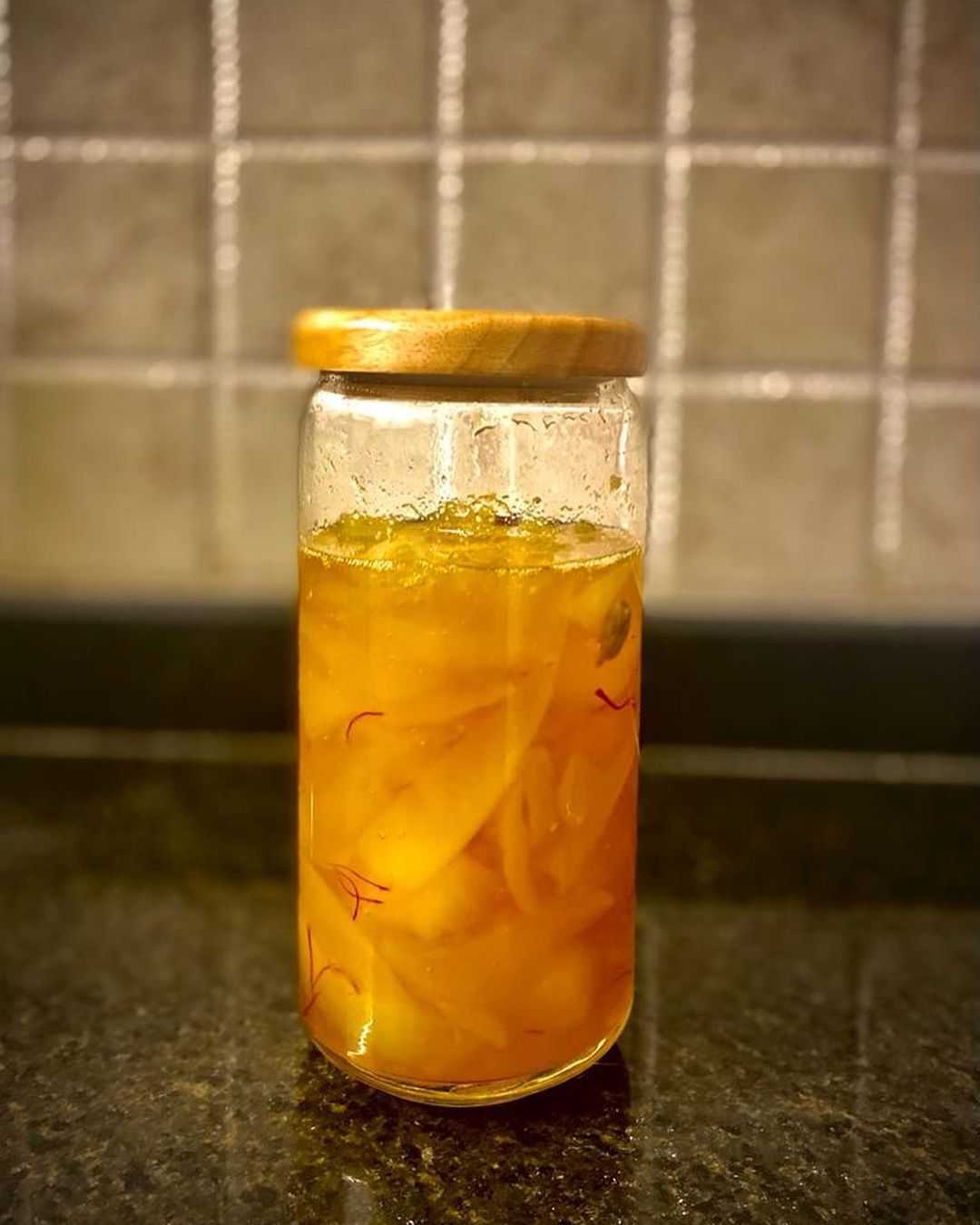Dipped in History & Health, What Makes ‘Amla Murabba’ a Timeless Winter Dish
You’ll hear many tales about the origins of murabba, but what remains common is that it’s a favourite of generations of Indians, whether for its nostalgia, or for its health benefits. Here’s its history and a quick recipe.

A sweet and spicy relish, the murabba finds its place in almost every Indian kitchen.
Having evolved from the idea of being able to enjoy fruits for months to come, the murabba has a rich legacy that explains its journey right from the kitchens of the Arabs to the dining tables of India.
To have the dish ready by the time the winter settles over your city, there’s no better time to start preparing it than right now.
But before we share a few recipes, here’s a deep dive into what made the murabba popular.

What is murabba?
Simply put, the murabba is a sweet preserve that is primarily made with fruits soaked in spices and sugars. While the choice of fruit can range from apples to cherries and even extend to vegetables like carrots, the most popular murabba varieties are mango and amla.
The science behind soaking fruits in sweetened syrup has come down through the ages as a way to prevent microbial spoilage.
It is said that soaking the fruit in syrup made of high-density sugars creates an environment that lowers water activity, thus preventing microbes from thriving. This ensures a longer shelf life, lasting taste, and a host of other benefits.
The history of the murabba
The basis for the recipe of the murabba is sugar, and hence to trace the dish’s history, it is vital to understand where sugar processing first started.
The story goes that it was the Indian subcontinent where sugar was first produced from sugarcane. Pressuring the sugarcane plant to extract the juice and then crystallising it through boiling was discovered around 350 AD, while the Gupta Dynasty was still reigning.
From then on, following the procurement of sugar, it was trade and exports that finally led to the murabba becoming a popular feature.
History says that when Darius the Great invaded India, he took sugarcane back to Persia, where the first instances of making jams were seen.
When the Arabs in Persia discovered this art, they began exploring it and identifying what other ways they could use to cook things in sugar, thus preserving them for a long time. They would call this fruit preserve anbijat, and eventually, they came to be called murabba.
However, the dish also has links to the Mughals and their arrival in the Indian subcontinent.
Did the Mughals love murabba?
Central Asian countries had a bounty of fruits and were well versed in preservation techniques.
It is said that when the Mughals came to India in 1526 from different parts of Central Asia, along with bringing their culture and heritage, they also brought the sweet dish murabba, which soon came to be a symbol of royalty.
One instance where this has been highlighted is when Daulat Khan Lodhi, the governor of Lahore, invited Babur to fight Ibrahim Lodhi, the Sultan of Delhi. The former sent Babur a jar of half-ripened mangoes that had been preserved in honey.
Babur not only accepted the initiation, but also went on to praise the dish, and extracts from history archives mention his words, “Unripe, they make excellent condiments, [but they] are good also preserved in syrup.”
The Mughals went on to relish the dish, which found a special spot in their trades.
Yet another story tells of how it may have been the Portuguese who brought the art of murabba to India.
Excerpts from the writings of Francis Bernier, a French physician and traveller who spent close to a decade in India, specifically Bengal, mention the murabba. “Among other fruits, they preserve large citrons, such as we have in Europe, a certain delicate root about the length of sarsaparilla, amba and pineapples, two common fruits of India, small myrobalan plums which are excellent, lemon and ginger.”

There are also theories that postulate that the morabba of Siuri in West Bengal had come down from the Portuguese.
Another murabba account says that in the mid-18th century, a gentleman named Hariprasad Dey went to Delhi, where he was so taken by the sweet petha that he learnt the technique of preparing it. On his return to Bengal, he started making it under the name of morabba.
Through the course of history, the murabba has stood the test of time. It continues to be a feature in winter specialities even today due to its multitude of benefits.
Why does India love her murabbas?
The best part of the sweet preserves is that its taste is not the only thing that makes it a hit in every home. Take, for instance, one of the most popular murabbas, amla. Here’s why it deserves a spot on your winter menu.
An immunity booster
Abundant in Vitamins A, C and E, the dish is your dose of health in every spoonful. With the prevalence of colds and flu in winter, the dish is an amazing one to include in your regime.
A digestive wonder
The method of preparing the murabba is such that the fibre content of the fruit or vegetable used remains intact, thus making it a wonderful aid in digestion. When mixed with sugar and honey, it is said to help in relieving gastritis.
Arthritis relief
A study to assess whether amla is good for people with arthritis due to its protective abilities against cartilage found that it does show a good response. This is due to the Vitamin C content and its role in promoting collagen synthesis.
Helps in iron deficiencies
Amla being a rich source of iron helps in increasing the haemoglobin levels in the blood, thus providing those with anaemia and other iron deficiencies, a way to manage their levels. This feature is also helpful for women who struggle with heavy bleeding during menstruation.
Cleanses the body
In an article to Health Shots, nutritionist Avni Kaul says amla is a great food to have as part of your diet. “It helps strengthen the liver and eradicates poisons from the body. Amla is also helpful for the brain and nervous system. It has excellent antiviral, antibacterial, and antifungal properties, and keeps your immune system in check.”
Now that you have discovered this wonderful dish, why not get started preparing it?
How to make murabba?
While making murabba is simple, the tricky part is achieving consistency.
In an article to Deccan Herald, Dheeraj Mathur, masterchef, Radisson Blu, Paschim Vihar, says, “The most important thing to keep in mind while making murabbas is the ratio of sugar and vinegar and then the addition of spices like kalonji, moti saunf (fennel seeds) and dalchini (cinnamon). One should also keep the murabbas dipped in sugar syrup in an air-tight container after keeping it in sunlight for three days.”
Here’s a recipe by Chef Sanjeev Kapoor for you to try out.
Amla Murabba Recipe:
Ingredients:
- Indian gooseberry (amla) 1 kg
- Sugar 1 1/2 kg
- Green cardamom seeds crushed 1 tsp
- Saffron (kesar) crushed 1 tsp
- Almonds blanched and slivered 10-15
Method
Step 1: Place amla in a pan, add two cups of water, and cover and cook on low heat for ten to fifteen minutes till the amla is tender and water has reduced to half the quantity.
Step 2: Remove the seeds and set them aside.
Step 3: Heat sugar with six cups of water in a thick-bottomed pan and prepare sugar syrup of one-string consistency.
Step 4: Add the cooked amlas along with the cooking liquour and stir.
Step 5: Add crushed green cardamom seeds and saffron, and continue to cook uncovered on low heat till the mixture is thick and translucent.
Step 7: The syrup by now should be of two-string consistency. Add almonds and stir gently. Cool and store in airtight jars.
Sources
Tracing the Journey of Murrabas from Central Asia to the Indian Kitchen by Anoothi Vishal, Published on 18 September 2017.
Thank Mughal love for fruit for murabba’s popularity in India by Priyadarshini Chatterjee, Published on 27 July 2022.
12 Amazing Amla Murabba Benefits: Digging Into The Sweet Relish by Divyansha Khatri, Published on 13 July 2018.
Chondroprotective Potential of Fruit Extracts of Phyllanthus emblica in Osteoarthritis, Published on 23 April 2007.
These 5 winter-friendly murabbas will add the right sweetness to your diet by Geetika Sachdev, Published on 23 November 2021.
Welcome winters with tangy murabbas by Neha Das, Published on 30 October 2014.
The morabba of Siuri was introduced by Portuguese, Published on 21 November 2020.
This story made me
- 97
- 121
- 89
- 167
Tell Us More
We bring stories straight from the heart of India, to inspire millions and create a wave of impact. Our positive movement is growing bigger everyday, and we would love for you to join it.
Please contribute whatever you can, every little penny helps our team in bringing you more stories that support dreams and spread hope.



















